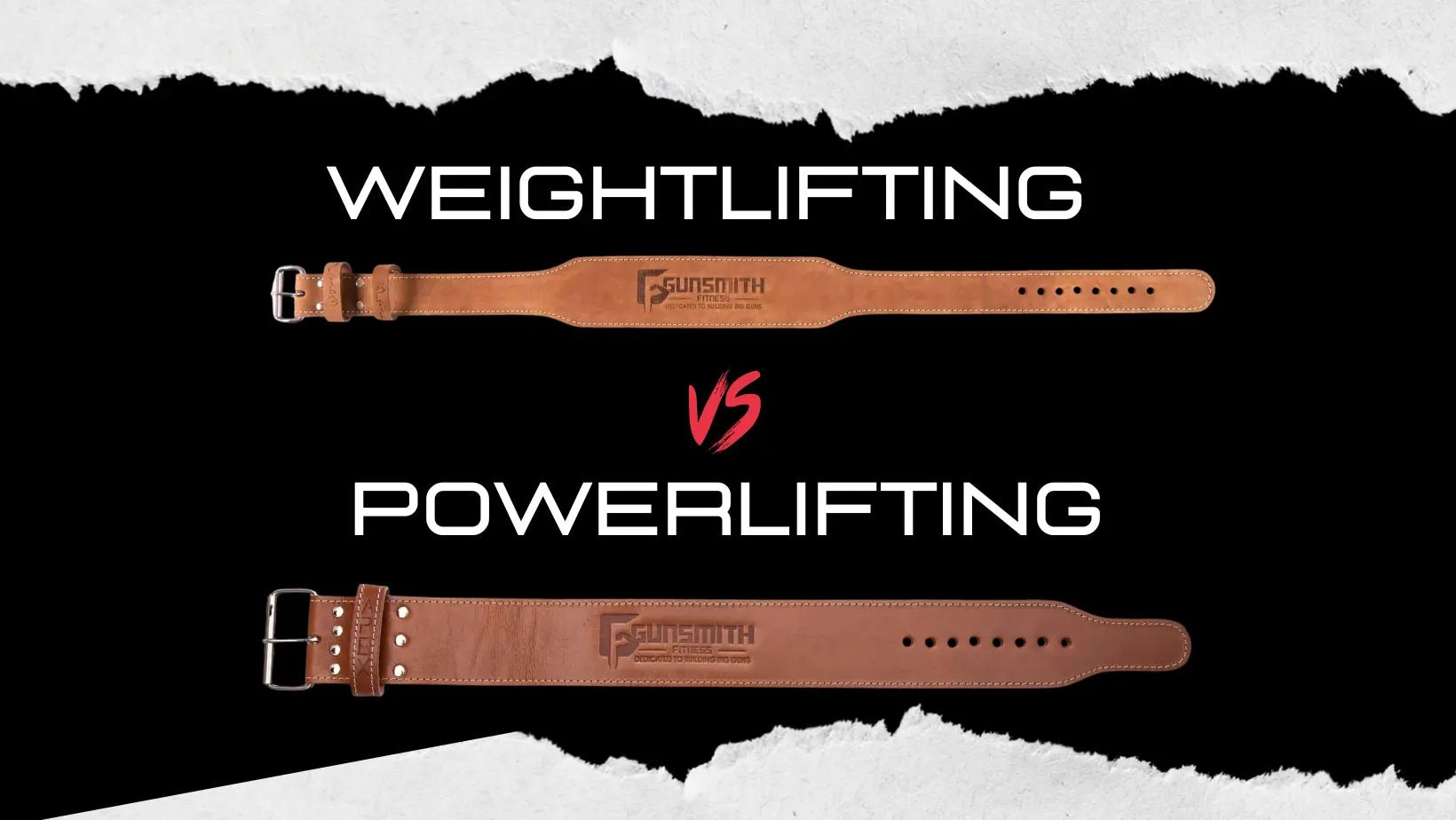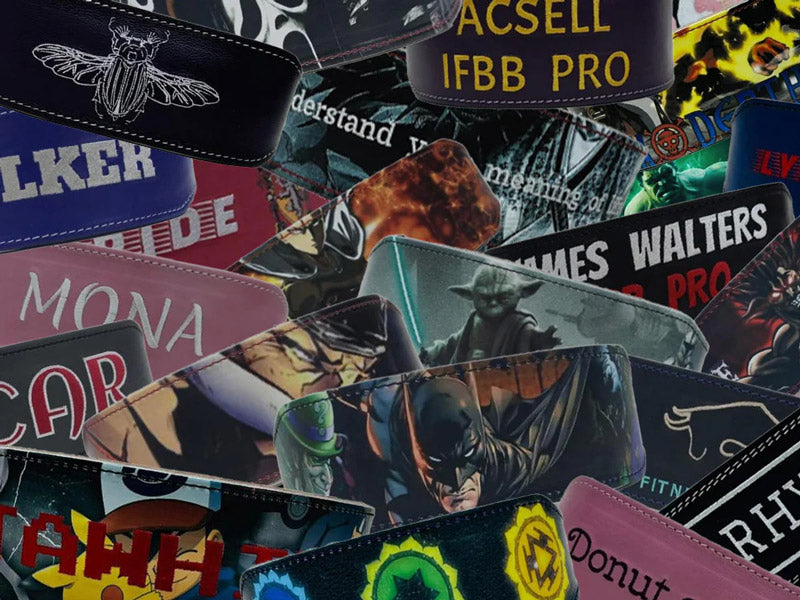
What's the Difference Between a Weightlifting Belt and a Powerlifting Belt?
Weightlifting Belt or Powerlifting Belt?
A quandary that's phased lifters since the dawn of time. OK maybe that's a bit of an exaggeration, but we get a ton of questions from people unsure of which one is right for them. The lifting belt is a critical accessory, providing valuable support during exercises that place a high amount of stress on the lower back. While there are several types of lifting belts available, two of the most popular are powerlifting belts and weightlifting belts, also known as Olympic belts. It is essential for athletes to understand the key differences between these two types of belts to ensure they select the appropriate one for their training needs and goals. Let's dive in...

A powerlifting belt, typically thicker and offering more support, is primarily designed for those who focus on the sport of powerlifting or strongman training, which includes the squat, bench press, and deadlift exercises. These belts are characterized by their rigid leather material and consistent width, typically around 4 inches and 10/13mm thick, throughout the entire length of the belt. This design provides maximum support for the abdominals and lower back, enabling powerlifters to brace their core effectively and lift heavier weights.
On the other hand, weightlifting belts/olympic belts cater to the needs of athletes within the sport of Olympic weightlifting, which involves the snatch and clean and jerk exercises. These belts are usually not as thick, typically 6/7mm and are tapered, with a wider back portion (approximately 4 inches) and a narrower front (about 3 inches). The reason for this design is to offer sufficient support while allowing for greater freedom of movement, crucial for executing the complex lifts associated with Olympic weightlifting. However, it's a solid all around belt, usually more comfortable, with padding and can be used for all lifts. So far so good, let's drill down further.
Weightlifting Belt vs Powerlifting Belt
Functionality Differences
Weightlifting belts and powerlifting belts serve different purposes for athletes involved in these two distinct disciplines. Weightlifting belts are primarily used in Olympic weightlifting, where the focus is on dynamic movements such as the snatch and clean & jerk. These belts offer athletes more flexibility and a greater range of motion, allowing them to perform these explosive lifts more efficiently.
Powerlifting belts, on the other hand, are designed for powerlifting, which involves the squat, bench press, and deadlift. These belts are generally more rigid to provide better stability and support during these heavy compound lifts. The increased rigidity helps powerlifters maintain proper form and generate higher intra-abdominal pressure, which in turn reduces strain on the lower back and spine.
Design and Structure Differences
-
Weightlifting Belts:
- Tapered design: Wider in the back (usually 4 to 6 inches) and thinner in the front (2 to 3 inches)
- Closure system: Commonly feature single prong or double prong
- Padding: May have additional padding or cushioning for comfort

-
Powerlifting Belts:
- Straight design: Consistent width all the way around (typically 4 inches)
- Closure system: Often use single prong, double prong, or lever buckles
- Stiffness: Rigid construction with minimal/no padding for increased stability
- Not as comfortable as a weightlifting belt

Material and Thickness Differences
Weightlifting belts are often made from materials such as nylon, or leather. They are lighter and less bulky compared to powerlifting belts, which allows for better speed and manoeuvrability during lifts. These belts may also have additional padding for extra comfort.
Powerlifting belts are usually made from heavy-duty leather and are typically 10mm or 13mm thick. The thickness and materials used give these belts a stiff construction that supports the bracing technique powerlifters use to lift heavy weights. The sturdiness of these belts may result in decreased comfort compared to weightlifting belts.
In summary, weightlifting belts and powerlifting belts are designed to cater to the specific demands of their respective sports. Weightlifting belts prioritize flexibility, range of motion, and comfort while powerlifting belts focus on providing maximum rigidity and stability for heavy lifts.
Choosing the Right Belt
Assessing Your Lifting Goals
Before choosing a belt, it's crucial to consider what type of lifting you intend to pursue. For strength-focused gym-goers, a powerlifting belt would provide additional support, particularly during squats and deadlifts. On the other hand, those seeking a more flexible and versatile experience may find greater value in a weightlifting belt, designed to promote mobility and speed.
Considering Your Body Type and Flexibility
An individual's body type and flexibility also play a significant role in selecting the right belt. The belt should sit just on top of the hip bone, and be comfortable across the rib cage and lumbar spine. Depending on preferences, some lifters may angle the belt up (above the belly button), straight across, or down (below the belly button). It's important to try various positions to determine the most comfortable fit, particularly for those with unique body proportions or physical restrictions. At Gunsmith Fitness, our Custom Belts can be tailored should you need a wider panel, from 3-6", this can suit those with a smaller or larger frame.

Selecting the Appropriate Material and Thickness
The choice between materials and thickness of a belt is another important factor. Belts are usually made of leather, nylon, or vinyl:
- Leather belts: Offer rigidity and support; come in different thicknesses (6/7mm/10mm/13mm) and can be either tapered or straight
- Nylon belts: Provide versatility, comfort, and flexibility; typically feature a quick-release buckle for fast adjustments
Personalized Options
If you're looking for something special, you may want to design your own belt. We offer that service:
- Leather type: Premium analine or suede options
- Shape: Whether a custom powerlifting belt or a personalized weightliftng belt
- Colours: A huge range of colours to suit your taste
- Buckle type and colour: Single/Double/Lever option
- Custom options: If you want text/logo or a full print design. Perhaps anime, Marvel, Dragonball Z, Pokemon, your favourite movie images, we can do them all.
- And many more configurations!

In conclusion, when choosing between a weightlifting and powerlifting belt, it is important to assess your lifting goals, consider your body type and flexibility, and select the appropriate material and thickness. By taking these factors into account, you can find the perfect belt for your personal needs and achieve your lifting goals.
Belt Features and Adjustments
Types of Buckles and Closures
There are several types of buckles and closures found on weightlifting and powerlifting belts to ensure a secure and tight fit. Common types include:
- Single Prong: A simple and easy-to-adjust option that consists of a single metal pin fitted through a hole in the belt.
- Double Prong: Similar to the single prong, but with two metal pins for added support and security.
- Lever: A popular choice for powerlifters, offering fast and consistent tightness adjusted with a lever mechanism.
- Velcro: Commonly found on weight belts designed for flexibility, often used in Crossfit

Width and Size Considerations
When selecting a belt for weightlifting or powerlifting, the width and size of the belt play a significant role in providing the necessary support and comfort during squats, deadlifts, or other lifts:
- Width: Belts come in varying widths, with powerlifting belts typically featuring a consistent width (4 inches) throughout the belt's length. Weightlifting belts, on the other hand, tend to have a tapered design for increased flexibility.
- Size: It's essential to choose a belt that fits snugly around your waist, sitting just on top of your iliac crest (the top of the hip bone). Adjustments for a secure fit can vary depending on the type of lift, with some athletes angling the belt up, straight across, or down based on their preferences.
By considering the different buckle and closure options, as well as the belt's width and size, weightlifters and powerlifters can select a belt that provides the appropriate support, flexibility, and comfort for their training or competition needs.
Quality
Not all belts are made the same. If you're looking on Amazon, perhaps that funky logo caught your eye, be a bit wary, especially if the price looks too good to be true. Chances are they are made with poor quality leather or even cardboard inners. That's not good, not good at all, they will fall to pieces in no time. Here's a bit more info
- Leather inner: A good/great belt will be made with a single 5mm piece of vegetable tanned leather. This means the belt will outlive you when cared for properly. A bad belt will be made with split leather, worse still, cardboard, this is a grey byproduct from most manufacturers. It may feel comfortable but it's poor quality and wont last long.
- Leather/Suede outers: A high quality belt will use think layers of full grain/upholstery quality leather on the outside and part touching your body. These will be soft to the touch and have a premium quality. Perhaps amara suede will be used. The best belts use cow leather, average belts might be buffalo leather. The worst belts are vinyl or artificial, you don't want that.
- Metals: The best belts use stainless steel hardware whether on the rivets or buckle. Poor belts use iron, which can rust. If we are talking levers, go for stainless steel, if it looks shiny, chances are it's pewter. They have a tendency to crack. That's the last think you want during a lift. We only use stainless steel on our levers, they come with a lifetime guarantee.

Using a Lifting Belt Properly
Correct Belt Positioning
When using a lifting belt, it's essential to position it correctly for optimal support and performance. For many people, the belt should sit just on top of their iliac crest (the top of the hip bone). Depending on the exercise, the angle of the belt can vary. During squats, some lifters may angle the belt up (above the belly button), straight across, or down (below the belly button).
To wear a lifting belt properly:
- Take a deep breath in
- Cinch the belt down as tight as you can around your midsection without restricting your airway
- Close the locking mechanism while maintaining a comfortable fit above the hips
Breathing and Bracing Techniques
Breathing and bracing techniques play a crucial role in stabilizing the torso during heavy lifts such as squats, deadlifts, and clean & jerk. By increasing intra-abdominal pressure (IAP), a lifting belt can help reduce stress on the lower back and prevent hyperextension.
To properly brace with a lifting belt, follow these steps:
- Stand upright with a neutral spine
- Inhale deeply through the nose, filling the diaphragm
- Hold your breath and brace your abdominal muscles
- Tighten the belt slightly to feel the pressure against your abdomen
- Perform the lift while maintaining this abdominal pressure
| Exercise | Key Points |
|---|---|
| Squat | Position the belt above, straight across, or below the belly button |
| Deadlift | Keep the torso and spine neutral while bracing with the belt |
| Clean & Jerk | Use the belt to stabilize the midsection and prevent hyperextension during the overhead movement |
In summary, using a lifting belt properly involves correct positioning, breathing, and bracing techniques. These practices help reduce stress on the lower back and enable lifters to perform heavy exercises like squats, deadlifts, and clean & jerk more effectively and safely.
Training Without a Lifting Belt
Building Core Strength
When training without a lifting belt, one of the primary benefits is the development of core strength. The absence of the belt allows the muscles around the abdomen and lower back to work harder, providing increased stability during lifts. This can lead to better balance, enhanced mobility, and overall improvement in performance. Some ways to build core strength without a lifting belt include:
- Incorporating exercises like planks, leg raises, and Russian twists
- Focusing on compound movements, such as squats and deadlifts, which naturally engage the core muscles
- Gradually increasing the intensity and volume of workouts to progressively challenge the core muscles

Improving Lifting Technique
Lifting without a belt can also help athletes refine their lifting technique. By relying on their own strength and stability, lifters are encouraged to maintain proper form and posture throughout each exercise. This can lead to a reduced risk of injury and better long-term results. To enhance lifting technique without using a belt, athletes can:
- Prioritize form over weight, ensuring proper body alignment before increasing the load
- Utilize lighter weights and higher reps to focus on movement control and muscle activation
- Employ accessory exercises targeting specific weak points that may inhibit good lifting technique
Popular Belt Recommendations
Apex Lever Belt
Our Belt is a popular choice among powerlifters due to its consistent width and durable construction. This belt is made of 10mm or 13mm thick genuine leather, providing strong support and a comfortable fit. The lever buckle allows for easy adjustments and a secure fit during lifts. Some advantages of the Apex Lever Belt are:
- High-quality leather for durability and comfort.
- 4-inch width all around, suitable for powerlifting.
- Lever buckle for quick adjustments.
- Available in a variety of colors and sizes.
Shibusa Weightlifting Belt
The Shibusa is one of our most popular belts and is a top choice for weightlifters, featuring a tapered design for more freedom of movement during lifts. The wider section in the back provides ample support, while the narrower front area offers flexibility. This belt is made of high quality leather with a cool retro look.
- Tapered design for range of motion.
- Wider back support and narrower front.
- Premium metal hardware.
- Available in 4" and 6" options.
Both these belts offer unique benefits for their respective users. Powerlifters seeking consistent width and strong support may prefer the Apex belt, while weightlifters desiring a more flexible and lightweight belt may find the Shibusa belt more suitable.






